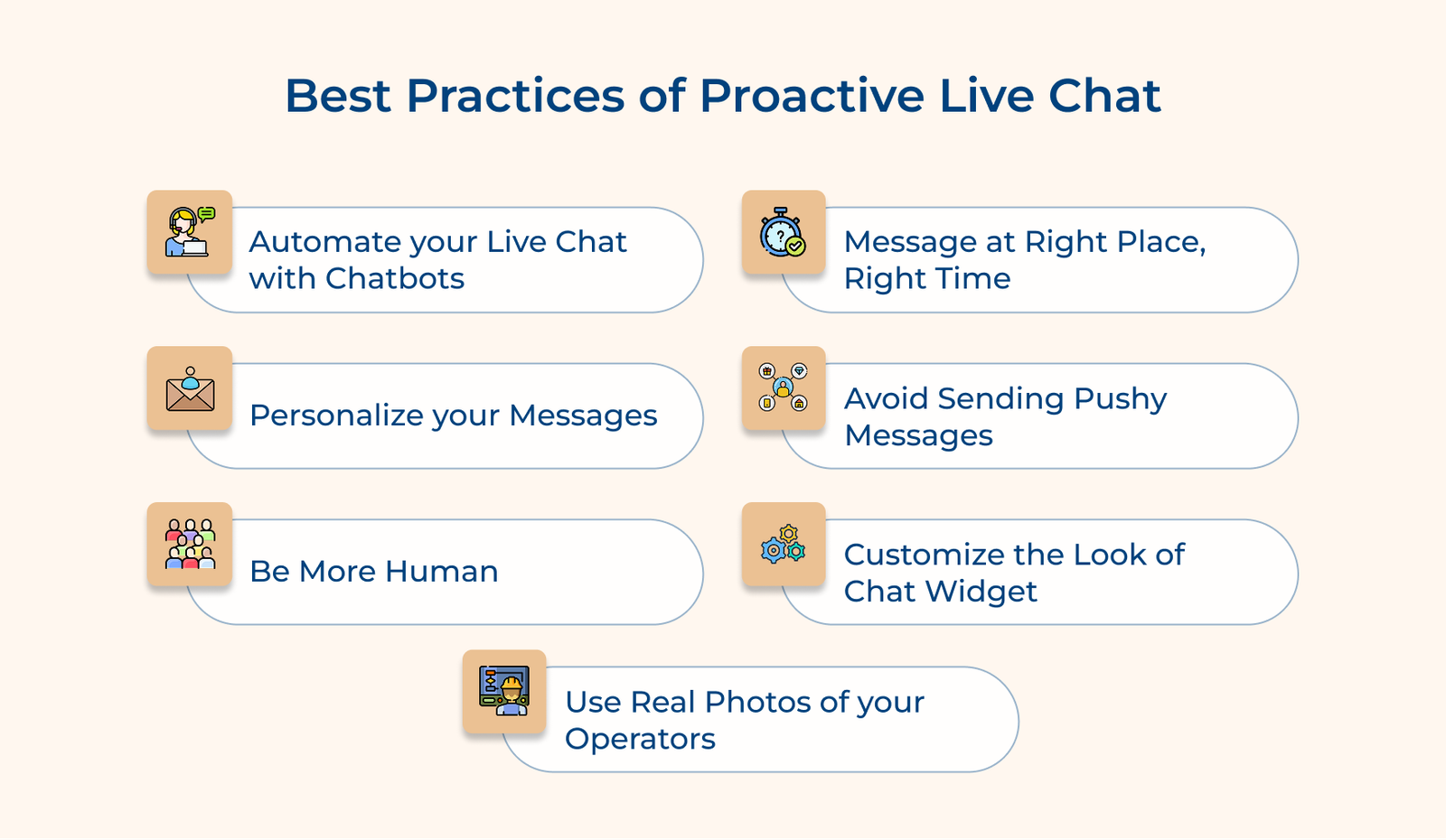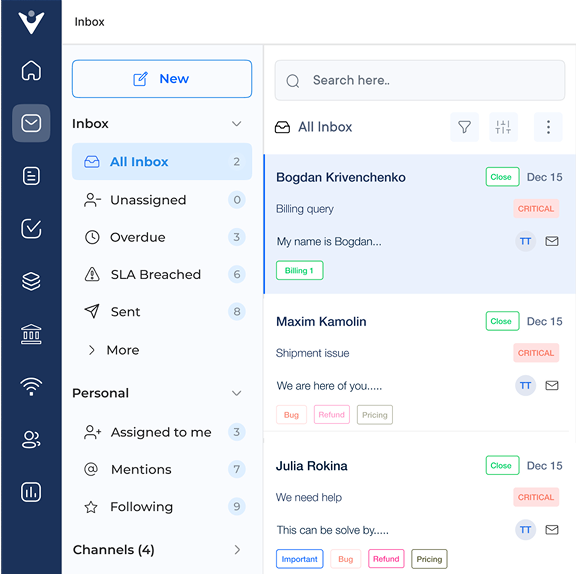1. Automate your Proactive Live Chat with Chatbots
A very effective strategy for maximizing the efficiency of proactive chat is to automate the process with chatbots. Chatbots can help personalize proactive chat invitations and engage more people instantly by providing immediate responses to common inquiries. More than 40% of customers are open to even buying items through a chatbot.
Let’s take an example of a website offering online fashion courses that can use chatbots to initiate a conversation with visitors who show interest. The chatbot can ask questions to understand the visitor’s preferences and provide personalized recommendations based on their responses. The level of personalization not only enhances the user experience but also increases the likelihood of converting visitors into customers.
Ways to implement:
- Use chatbot scripts to tailor messages based on user behavior and demographics.
- Integrate chatbots with customer relationship management (CRM) software to access and utilize customer data effectively.
- Continuously analyze or optimize chatbot performance to ensure successful interactions and meaningful engagement with website visitors.
2. Set Up Messages to Appear at the Right Place at the Right Time
Proactive live chat is an essential tool for engaging website visitors and providing personalized assistance in real-time. Setting up messages to appear at the right place at the right time is very important. It means delivering chat invitations or messages based on specific user behaviors ensuring that they are relevant and timely.
Implementing this best practice allows the brand to personalize proactive chat invitations and engage more people instantly. Let’s take an example of a brand that can set up messages to appear when a visitor spends a certain amount of time on a particular page. The brand can set up a hovering over the checkout button without proceeding to purchase. The targeted approach can help the brand capture users’ attention at the most opportune moments.
Tips for implementation:
- Use website analytics to track user behaviors and identify key touchpoints where proactive chat messages can be most impactful.
- Segment the audience based on demographics, browsing history or previous interactions with the brand to tailor chat invitations to their specific needs.
- Test different messaging strategies or timing options to determine the most effective approach for engaging the audience and driving conversions.
3. Personalize your Messages — It Truly Matters
Personalizing messages in proactive live chat interactions can make a significant impact on customer satisfaction, engagement and conversion rates. 76% of customers said personalized messages were essential in enhancing their consideration of a brand. Addressing customers by their names allows the brand to create a more personalized and meaningful experience for them.
- A customer visits a website and is greeted with a personalized message that mentions their recent purchase. It demonstrates the company’s commitment to its customers and promotes a strong sense of loyalty.
- During a live chat conversation, a customer expresses frustration with a product issue. Addressing the customer by name and showing empathy creates a more personalized experience.
- A user receives a proactive chat invitation on the website that offers personalized product recommendations. The customers can easily find what they are looking for and it can boost their chances of making a purchase.
Pro tips:
- Use customer relationship management (CRM) software to track customer interactions and preferences.
- Train live chat agents to personalize messages based on available data and customer feedback.
- Utilize chatbots with AI capabilities to gather real-time data and provide personalized responses to customers.
4. Avoid Sending Pushy Messages
When businesses are using proactive live chat, it’s extremely important to avoid sending pushy messages. Pushy messages can come off as aggressive or intrusive, which can turn potential customers away. It’s important to focus on being helpful and informative in live chat interactions. Use cases showcasing the importance of avoiding pushy messages include:
- A customer is browsing the website but is not ready to make a purchase. Sending pushy messages urging them to buy now can make them feel pressured and lead them to abandon their cart.
- A visitor is exploring services but has questions about pricing. Instead of bombarding them with pushy sales pitches, offering helpful information and guidance can build trust.
- A user is experiencing technical difficulties on the website. Sending pushy messages demanding they take action can frustrate them even more. Providing proactive assistance and troubleshooting tips here is better as it will create a positive customer experience.
Important things to consider:
- Personalize messages based on the customer’s behavior and preferences.
- Offer helpful suggestions or recommendations without pressuring the customer to make a purchase.
- Provide clear options for the customer to opt out of live chat tools messages if they prefer not to receive them.
5. Be More Human
“Be more human” is a key best practice in proactive live chat that emphasizes the importance of personalizing chat invitations to engage with customers. Humanizing chat interactions allows the brand to create a more genuine connection with customers. It increases the likelihood of them engaging in conversation.
Implementing this best practice allows the brand to tailor chat invitations based on specific customer behaviors or preferences. Let’s look at an example of a brand that can use data from a customer’s browsing history to personalize your message. The brand can now initiate a conversation that is relevant to the customer’s needs and interests.
Ways to implement:
- Be conversational: Avoid using robotic language or scripted responses in chat interactions. Strive to make messages sound more natural and engage customers in a genuine conversation.
- Provide real-time support: Offer immediate assistance to customers through live chat by responding promptly to inquiries and providing helpful solutions.
6. Customize the Look of your Chat Widget
Proactive live chat is a game-changer. One of the best practices of proactive chat is to customize the look of the chat widget. It not only helps to make the chat widget more visually appealing but also ensures that it fits seamlessly into the website’s design. Creating a more cohesive user experience. Use cases showcasing the importance of customizing the look of the chat widget are:
1. Branding: Customizing chat widgets with the company’s logo or colors helps to reinforce the brand identity and create a sense of familiarity for users.
2. Personalization: Tailoring the look of the chat widget to match the style of the website can make users feel like they are chatting with a real person, rather than a generic chatbot.
3. Accessibility: Customizing the look of the chat widget allows the brand to make it easier for users to find and engage with the chat feature. Leading to higher levels of customer satisfaction.
Pro tips:
- Use a chat widget customization tool or software that allows the brand to easily change the colors, fonts and other design elements of the chat widget.
- Test different variations of the chat widget design to see which one resonates best with the users and leads to higher engagement rates.
- Collect feedback from users about the look and feel of the chat widget and use this information to continuously refine or improve its design.
7. Use Real Photos of Your Operators in Live Chat Triggers
Businesses must use real photos of the operators in live chat triggers. The technique helps to personalize proactive chat invitations and engage more people instantly. Using real photos allows the brand to create a more human connection with the website visitors which makes them more likely to respond to the chat invitations.
Let’s take an example of a brand that can include photos of the actual operators in the chat triggers instead of using generic images or icons. It allows visitors to see who they will be chatting with, creating a sense of trust and familiarity.
How to implement:
- Take high-quality photos of your operators: Make sure to use clear, professional photos of the operators to give a good first impression to website visitors.
- Include personal information in chat triggers: Along with the photo the brand can also include a brief bio or fun fact about the operator to make the chat invitation even more personal.
- Rotate photos regularly: Keep the chat triggers fresh and engaging by rotating the photos of the operators regularly. It shows that there are real people behind the chat, ready to assist visitors at any time.
Proactive Live Chat Use Cases and Examples
Explore various proactive live chat use cases along with examples to understand how businesses are enhancing customer engagement, boosting sales and resolving issues faster.


















